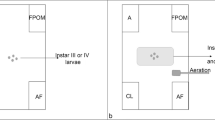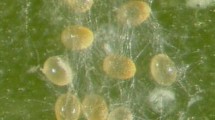Abstract
Cunaxa capreolus Berlese failed to develop on diets of plant material but developed equally well on diets of booklice (Psocoptera) or of the citrus brown mite,Eutetranychus orientalis (Klein), which were eaten in their active stages and not as eggs. Cannibalism occurred during shortage of food. Although the growth of the immature stages ofC. capreolus was accompanied by an increasing consumption of prey, yet their total consumption was less than 30% of that of the female adult. The number of prey individuals consumed byC. capreolus was inversely related to temperature but consumption rate increased slightly with increasing temperature.
Résumé
Cunaxa capreolus Berlese ne se développe pas à partir de matières végétales tandis que lui convient également bien une alimentation à base de psoques ou de l'acarien des citrus,Eutetranychus orientalis (Klein), qui sont consommés à l'état de stades mobiles mais non d'œufs. En cas de manque de nourriture, du cannibalisme se manifeste. Au cours de l'évolution des stades immatures deC. capreolus il y a une augmentation de la consommation des proies, mais la consommation totale de ces stades est inférieure à 30% de celle des femelles adultes. Le nombre de proies dévorées est en rapport inverse avec la température, mais le taux journalier de consommation augmente lentement avec celle-ci.
Similar content being viewed by others
References
Lord, F. T. — 1949. The influence of spray programs on the fauna of apple orchards in Nova scotia. III. mites and their predators. —Can. Entomol., 81, 202–214, 217–230.
Meyer, M. K. P. &Ryke, P. A. J. — 1959.Cunaxidae [Acarina: Prostigmata] occurring on plants in South Africa. —Ann. Mag. Nat. Hist. Ser. 13, 369–384.
Muma, M. H. — 1960. Predatory mites of the familyCunaxidae associated with citrus in Florida. —Ann. Entomol. Soc. Am., 53, 321–326.
— — 1965. Population of common mites in Florida citrus groves. —Fla. Entomol, 48, 35–46.
Rasmy, A. H., Zaher, M. A. &Abou-Awad, B. A. — 1972. Mites associated with deciduous fruit trees in U.A.R.. —Z. Angew. Entomol., 70, 179–183.
Soliman, Z. R. &Mohamed, I. M. — 1972. Biological studies on the soil-inhabiting Bdellid mite,Spinibdella bifurcata [Acarina-Bdellidae] in U.A.R.. —Z. Angew. Entomol., 70, 15–23.
Zaher, M. A., Wafa, A. K. &Shehata — 1969. Life history of the predatory mitePhytoseius plumifer and the effect of nutrition on its biology [Acarina: Phytoseiidae]. —Entomol. Exp. Appl., 12, 383–388.
Zaher, M. A., Wafa, A. K., Ali, M. &Rasmy, A. H. — 1970. Survey of mites associated with citrus trees in Egypt and Gaza strip. —Bull. Soc. Entomol. Egypte, 54, 73–79.
Author information
Authors and Affiliations
Rights and permissions
About this article
Cite this article
Zaher, M.A., Soliman, Z.R. & El-Bishlawy, S.M. Feeding habits of the predaceous mite,Cunaxa capreolus [Acarina: Cunaxidae] . Entomophaga 20, 209–212 (1975). https://doi.org/10.1007/BF02371661
Issue Date:
DOI: https://doi.org/10.1007/BF02371661




